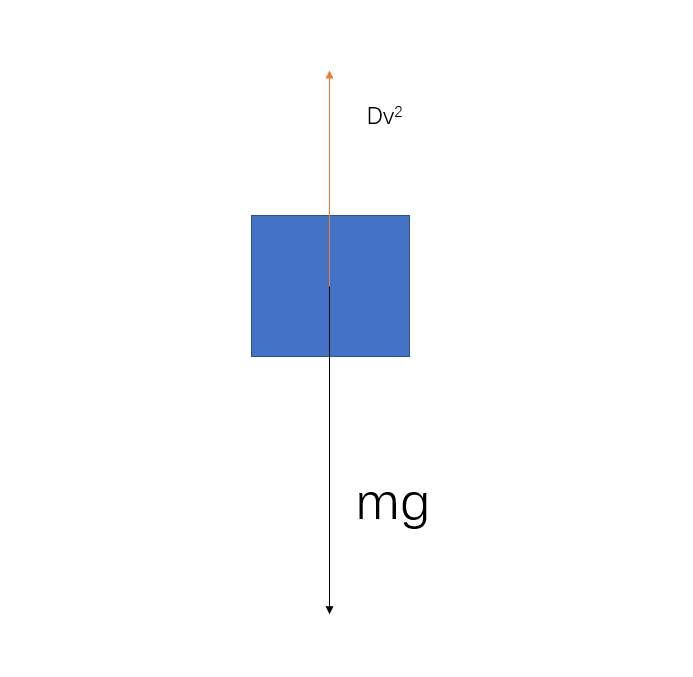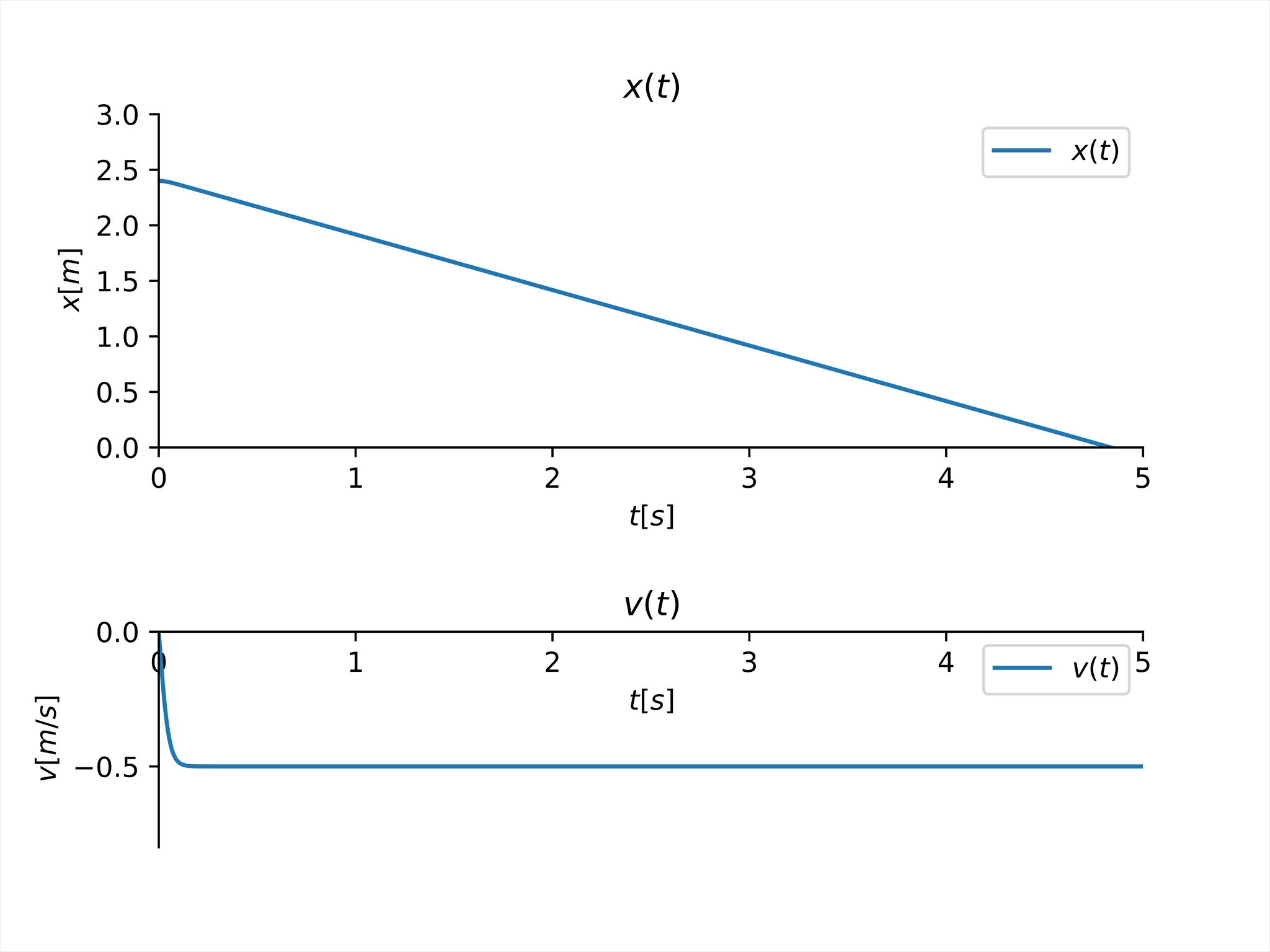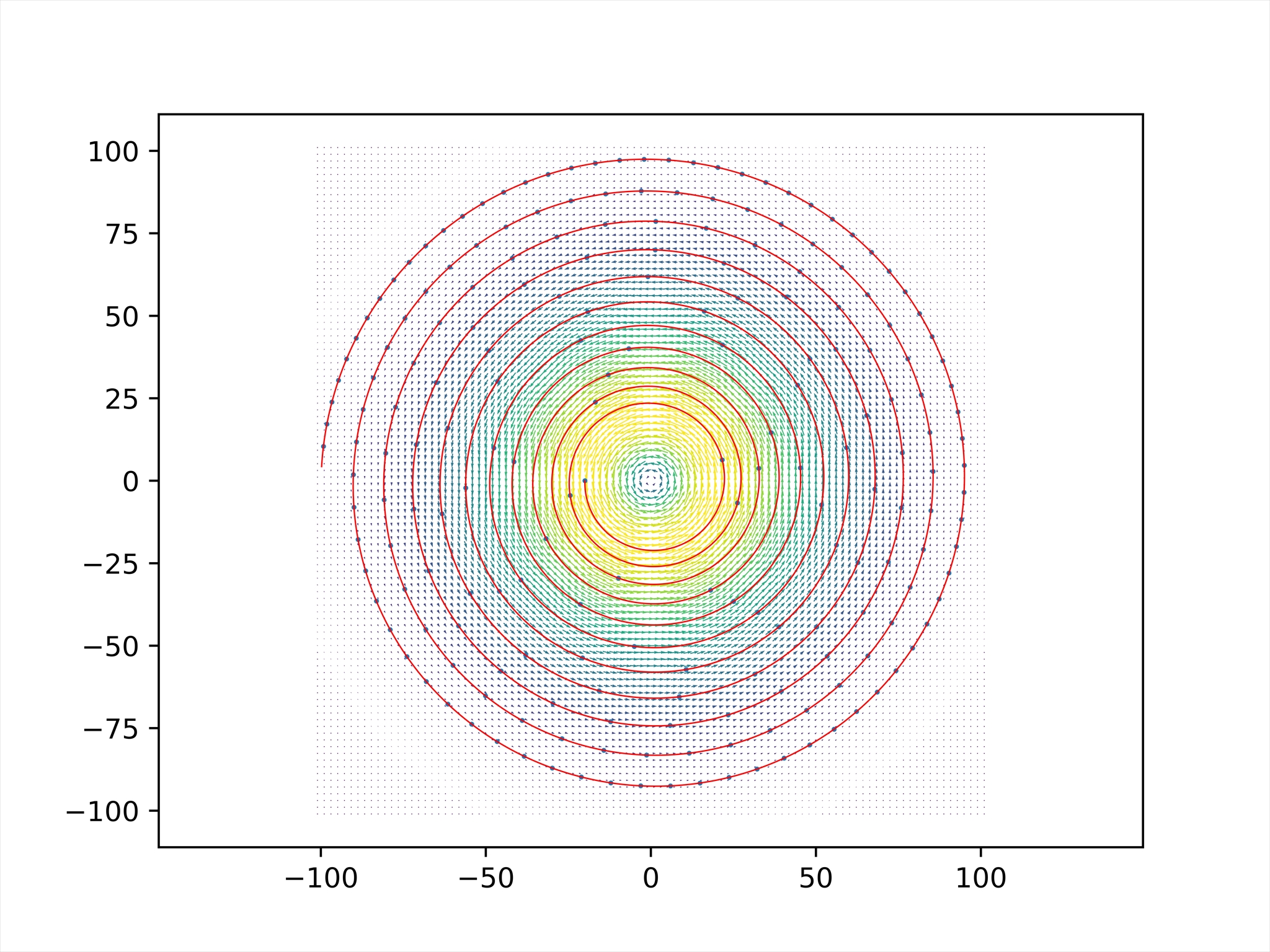[Elementary Mechanics Using Python-02]Feather in tornado
Problem
9.17 Feather in tornado.
In this project you will learn to use Newton’s laws and the force model for air resistance in a wind field to address the motion of a light object in strong winds. We start from a simple model without wind and gradually add complexity to the model, until we finally address the motion in a tornado. Motion without wind:
First, we address the motion of the feather without wind.
(a) Identify the forces acting on a feather while it is falling and draw a free-body diagram for the feather.
(b) Introduce quantitative force models for the forces, and find an expression for the acceleration of the feather. You may assume a quadratic law for air resistance.
(c) If you release the feather from rest, its velocity will tend asymptotically toward the terminal velocity, \(v_T\) . Show that the terminal velocity is \(v_T\) = \(−(mg/D)^{1/2}\), where D is the constant in the air resistance model.
(d) We release the feather from a distance h above the floor and measure the time t until the feather hits the floor. You may assume that the feather falls with a constant velocity equal to the terminal velocity. Show how you can determine D/mg by measuring the time t. Estimate D/mg when you release the feather from a height of 2.4 m above the floor and it takes 4.8 s until it hits the floor.
(e) We will now develop a more precise model where we do not assume that the velocity is constant. You release the feather from the height h at the time t = 0 s. Find the equation you have to solve to find the position of the feather as a function of time. What are the initial conditions?
(f) Write a program that solves this equation to find the velocity and position as a function of time t. Use the parameters you determined above, and test the program by ensuring that it produces the correct terminal velocity.
(g) Fig. 9.19 shows the position and velocity calculated with the program using the parameters found above. Was the approximation in part (d) reasonable? Explain your answer. Model with wind: We have now found a model that can be used to find the motion of the feather. We will now find the motion of the feather in three dimensions while it is blowing. The velocity of the wind varies in space, so that the wind velocity w is a function of the position r. We write this as w = w(r).
(h) Find an expression for the acceleration of the feather. The expression may include the wind velocity w(r). Let the z-axis correspond to the vertical direction.
(i) Assume that the feather is moving in an approximately horizontal plane—that is you may assume that the vertical acceleration is negligible. How does the wind have to blow in order for the feather to move in a circular orbit of radiusr0 with a constant speed v0?
Motion in a tornado: For a tornado with a center at the origin, the wind velocity is expected to be approximately given by the model:
\[\boldsymbol{w}(\boldsymbol{r}) = u_0\boldsymbol{r}e^{−r/R}\hat{u_θ} = u_0(-y, x,0)e^{−r/R}\hat{u_θ} , \space \space (9.79)
\]where u0 is a characteristic velocity for the wind, R is the radius of the tornado, and uˆθ is a tangential unit vector in the horizontal plane (\(\hat{u_\theta}\) is normal to r). Here, r = (x, y,z), and r = |r|. The velocity field is illustrated in Fig. 9.20.
(j) Is is possible to choose an appropriate set of initial conditions so that the feather moves in a circular path in the tornado? Explain your answer.
(k) Rewrite your program to find the velocity and position of the feather as a function of time. For the tornado you may use the values u0 = 100 m/s and R = 20 m.
(l) Find the trajectory for the feather if it is released from rest from a height of 2.4m, and in a position corresponding to r = −R i + hk. (m) The trajectory of the feather is shown in Figs. 9.20 and 9.21. Compare the results with what happended when you dropped the feather without wind. Why does the feather now take longer to reach the ground?
Solution
\((a)\)
考虑无风情况,\(\boldsymbol{w} = \boldsymbol{0}\),很容易画出受力分析图

\((b)\)
由受力分析图可以简单的列出动力学方程
\]
\(\Rightarrow\)
\]
\((c)\)
我们令 \(\boldsymbol{a} = \boldsymbol{0}\), 得到方程
\]
\(\Rightarrow\)
\]
\((d)\)
由\((c)\)中公式,我们列出
\]
将\(v_T = -\sqrt[]{\frac{mg}{D}}\)带入求解,得
\]
\((e)\)
此问方程就是\((b)\)中得到的方程
\]
\((f)\)
编程实现
import numpy as np
import matplotlib.pyplot as plt
G = 9.81
H = 2.4
dt = 0.001
C = 4 # D/mg
t = np.arange(0, 5, 0.001)
a = np.zeros(5000, dtype=float)
v = np.zeros(5000, dtype=float)
x = np.zeros(5000, dtype=float)
a[0] = -G
v[0] = 0
x[0] = H
for index in range(1, 5000):
a[index] = (-1 + C*v[index-1]**2)*G
v[index] = v[index-1] + a[index-1]*dt
x[index] = x[index-1] + v[index-1]*dt
plt.subplot('211')
plt.title('$x(t)$')
ax = plt.gca()
ax.spines['right'].set_color('none')
ax.spines['top'].set_color('none')
ax.spines['bottom'].set_position(('data', 0))
plt.plot(t, x, label="$x(t)$")
plt.xlim([0, 5])
plt.ylim([0, 3])
plt.xlabel('$t[s]$')
plt.ylabel('$x[m]$')
plt.legend()
plt.subplot('313')
plt.title('$v(t)$')
ax = plt.gca()
ax.spines['right'].set_color('none')
ax.spines['top'].set_color('none')
ax.spines['bottom'].set_position(('data', 0))
plt.plot(t, v, label="$v(t)$")
plt.xlim([0, 5])
plt.ylim([-0.8, 0])
plt.xlabel('$t[s]$')
plt.ylabel('$v[m/s]$')
plt.legend()
plt.savefig('f.jpg', dpi=3000)

\((h)\)
考虑上风力,改为相对于风的速度
\]
\((i)\)
忽略铅锤方向加速度,\(让g \rightarrow 0, 且当\boldsymbol{a}=-\frac{v_0^2}{r_0}\hat{r}时:\\\)
\]
解出\(\boldsymbol{w}\)
\]
\((j)\)
首先列出羽毛的微分方程
\]
找到初值条件
&\boldsymbol{x}(0) = [-20, 0, 2.4] \\
&\boldsymbol{v}(0) = [0, 0, 0] \\
&\boldsymbol{a}(0) = -(\boldsymbol{k} + \frac{D}{mg}|\boldsymbol{v}(0)-\boldsymbol{w}(\boldsymbol{x}(0))|(\boldsymbol{v}(0)-\boldsymbol{w}(\boldsymbol{x}(0))))g\\
\end{align}\end{matrix}\right.
\]
编程实现
import numpy as np
import matplotlib.pyplot as plt
// 定义常量
u0 = 100
R = 20
H = 2.4
G = 9.81
k = np.array([0, 0, 1])
C = 4 # D/mg
def Len(vector):
return np.sqrt(vector[0]**2+vector[1]**2+vector[2]**2)
// 风场函数
def w(xVector, yVector, zVector=0):
rLen = Len([xVector, yVector, zVector])
return np.array([u0*np.exp(-rLen/R)*(-yVector), u0*np.exp(-rLen/R)*xVector, u0*np.exp(-rLen/R)*0])
// 加速度函数
def A(v, r):
W = w(r[0], r[1], r[2])
return -(k+C*(v - W)*Len((v - W)))*G
// 创建网格
xVector, yVector= np.meshgrid(
np.linspace(-101, 101, 100),
np.linspace(-101, 101, 100)
)
// 计算风场
uVector, vVector, wVector = w(xVector, yVector)
M = np.hypot(uVector,vVector)
// 绘制风场
plt.quiver(
xVector, yVector,
uVector, vVector,
M, pivot='mid', width=0.001
)
dt = 0.00001
tMax = 30
t = np.arange(0, tMax, dt)
x = np.zeros((int(tMax/dt), 3))
v = np.zeros((int(tMax/dt), 3))
a = np.zeros((int(tMax/dt), 3))
// 初值条件
v[0,:] = np.array([0, 0, 0])
x[0,:] = np.array([-20, 0, H])
a[0,:] = A(v[0,:], x[0,:])
// 数值积分
i = 0
for index in range(1, 3000000):
a[index,:] = A(v[index-1,:], x[index-1,:])
v[index,:] = v[index-1,:] + a[index-1,:]*dt
x[index,:] = x[index-1,:] + v[index-1,:]*dt
if x[index,2] <= 0:
i = index
print("drop at {} s".format(i*dt))
break
// 绘制羽毛轨迹
plt.plot(x[:i,0], x[:i,1], 'r', linewidth=0.5)
plt.scatter(x[:i:10000,0], x[:i:10000,1], s=0.6)
plt.xlim([-101, 101])
plt.ylim([-101, 101])
plt.axis('equal')
plt.savefig('1.jpg', dpi=3000)

结论
在龙卷风影响下,计算出羽毛要经过 \(20.59065 s\) 落到地面,远大于无风情况下的情况,主要原因是采用了平方模型,使得空气阻力非线性。
[Elementary Mechanics Using Python-02]Feather in tornado的更多相关文章
- Python(九)Tornado web 框架
一.简介 Tornado 是 FriendFeed 使用的可扩展的非阻塞式 web 服务器及其相关工具的开源版本.这个 Web 框架看起来有些像web.py 或者 Google 的 webapp,不过 ...
- python web框架——初识tornado
一 Tornado概述 Tornado是FriendFeed使用的可扩展的非阻塞式web框架及其相关工具的开源版本.这个Web框架看起来有些像web.py或者Google的 webapp,不过为了能有 ...
- Python学习笔记17—Tornado
实例 #!/usr/bin/env Python #coding:utf-8 import tornado.httpserver import tornado.ioloop import tornad ...
- python web框架之Tornado
说Tornado之前分享几个前端不错的网站: -- Bootstrap http://www.bootcss.com/ -- Font Awesome http://fontawesome.io/ - ...
- 【Python】linux安装tornado
想写个页面,又不想用tomcat,同事说可以用tornado,试一下 1 我从网上找了个hello world类似的程序,复制粘贴运行,提示 ImportError: No module named ...
- Python Web 框架:Tornado
1.Tornado Tornado:python编写的web服务器兼web应用框架 1.1.Tornado的优势 轻量级web框架 异步非阻塞IO处理方式 出色的抗负载能力 优异的处理性能,不依赖多进 ...
- python web框架之Tornado的简单使用
python web框架有很多,比如常用的有django,flask等.今天主要介绍Tornado ,Tornado是一个用Python写的相对简单的.不设障碍的Web服务器架构,用以处理上万的同时的 ...
- 在学习python的Django\Flask\Tornado前你需要知道的,what is web?
我们都在讲web开发web开发,那到底什么是web呢? 如果你正在学习python三大主流web框架,那这些你必须要知道了 软件开发架构: C/S架构:Client/Server 客户端与服务端 ...
- python 02
函数的参数 默认参数: 函数的基本形参, 可以有默认参数, 什么是基本形参呢, 就是普通变量, 如字符串, 数字等. 并且带有默认参数的形参, 要放在后边. 传参时, 不必将所有的参数都传递, 可以只 ...
随机推荐
- 服务注册与发现-Eureka (高可用设计)
什么是高可用 部署需要考虑的是什么: 1.系统遇到单点失效问题,如何能够快速切换到其他节点完成任务 2.如何应对网络故障,即系统如何设计成"故障开放型"(expecting fai ...
- HTTP常见状态码(200、301、302、404、500、502)详解
概述 运维工作中,在应用部署的时候,通常遇到各种HTTP的状态码,我们比较常见的如:200.301.302.404.500.502 等,有必要整理一份常见状态码的文档,加深印象,方便回顾. ...
- Redis 的缓存淘汰机制(Eviction)
本文从源码层面分析了 redis 的缓存淘汰机制,并在文章末尾描述使用 Java 实现的思路,以供参考. 相关配置 为了适配用作缓存的场景,redis 支持缓存淘汰(eviction)并提供相应的了配 ...
- HDU 3341 Lost's revenge (AC自动机 + DP + 变进制/hash)题解
题意:给你些分数串,给你一个主串,主串每出现一个分数串加一分,要你重新排列主串,最多几分 思路:显然这里开$40^4$去状压内存不够.但是我们自己想想会发现根本不用开那么大,因为很多状态是废状压,不是 ...
- Gym 100796B Wet Boxes(思维)题解
题意:给一个如图坐标系,每个方形都放在下面两个中间,已知一个木块湿了那么他下面所有的都会湿,显然,不能湿两次.问,每次给出一个坐标,把他弄湿,有几个木块从干变成湿了. 思路:我们把坐标系拉直,就变成了 ...
- HTML教程(看完这篇就够了)
HTML教程 超文本标记语言(英语:HyperText Markup Language,简称:HTML)是一种用于创建网页的标准标记语言.您可以使用 HTML 来建立自己的 WEB 站点,HTML 运 ...
- CSS3 动态生成内容(在Web中插入内容)====CSS的伪类或者伪元素
# css3 .类:伪类::伪元素 /* CSS3伪元素/伪类 :https://www.w3.org/TR/css3-selectors/#selectors ::selection 伪元素(F12 ...
- 微前端 & 微前端实践 & 微前端教程
微前端 & 微前端实践 & 微前端教程 微前端 micro frontends https://micro-frontends.org/ https://github.com/neul ...
- GitHub 500 error
GitHub 500 error 无法访问了, GitHub 挂了又! error reports Downdetector Github down? Current service status a ...
- Typescript All In One
Typescript All In One TypeScript 3.5 is now available. https://www.typescriptlang.org/#download-link ...
